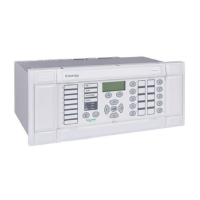P54x/EN TS/La4 Troubleshooting
(TS) 12-8
MiCOM P543, P544, P545 & P546
TS
7.2 Failure of opto-isolated inputs
The opto-isolated inputs are mapped onto the relay internal signals using the programmable
scheme logic. If an input does not appear to be recognized by the relay scheme logic the
Commission Tests/Opto Status menu option can be used to verify whether the problem is in
the opto-isolated input itself or the mapping of its signal to the scheme logic functions. If the
opto-isolated input does appear to be read correctly then it will be necessary to examine its
mapping within the programmable logic.
Ensure the voltage rating for the opto inputs has been configured correctly with applied
voltage. If the opto-isolated input state is not being correctly read by the relay the applied
signal should be tested. Verify the connections to the opto-isolated input using the correct
wiring diagram. Next, using a voltmeter verify that 80% opto setting voltage is present on the
terminals of the opto-isolated input in the energized state. If the signal is being correctly
applied to the relay then the failure may be on the input card itself. Depending on which
opto-isolated input has failed this may require replacement of either the complete analog
input module (the board within this module cannot be individually replaced without
re-calibration of the relay) or a separate opto board.
7.3 Incorrect analog signals
The me
asurements may be configured in primary or secondary to assist. If it is suspected
that the analog quantities being measured by the relay are not correct then the measurement
function of the relay can be used to verify the nature of the problem. The measured values
displayed by the relay should be compared with the actual magnitudes at the relay terminals.
Verify that the correct terminals are being used (in particular the dual rated CT inputs) and
that the CT and VT ratios set on the relay are correct. The correct 120 degree displacement
of the phase measurements should be used to confirm that the inputs have been correctly
connected.
7.4 Current differential failures
The Co P
rocessor board may cause the relay to report one or more of the following alarms:
Signaling failure alarm (on its own)
This indicates that there is a problem with one of the fiber optic signaling channels. This
alarm can occur in dual redundant or three terminal schemes. The fiber may have been
disconnected, the relay incorrectly configured at one of the ends, or there is a problem with
the communications equipment if P59x relays are being used. The current differential
protection is still in service. Further information about the status of the signaling channels
can be found in MEASUREMENTS 4 column.
Signaling failure and C diff failure alarms together
This indicates that there is a problem with one or both fiber optic signaling channels. The
fiber may have been disconnected, the relay incorrectly configured at one of the ends, or
there is a problem with the communications equipment if P59x relays are being used. As a
result the current differential protection is not available and backup protection will operate, if
configured to do so. Further information about the status of the signaling channels can be
found in MEASUREMENTS 4 column.
C diff failure alarm (on its own)
This indicates there is a problem with the Co - Processor board. As a result the current
differential/distance protection is not available and backup protection will operate, if
configured to do so. Further information can be found in the maintenance records.
Incompatible relay
This occurs if the relays trying to communicate with each other are of incompatible types.
Relay types P541 and P542 can be freely mixed. Relay type P543, P544, P545 and P546
can be freely mixed. However, the two groups are mutually exclusive.

